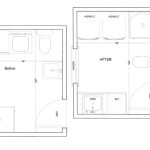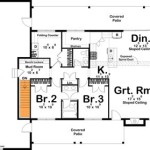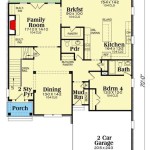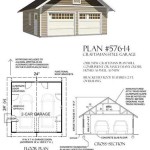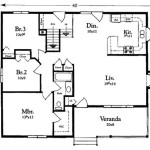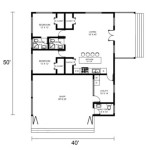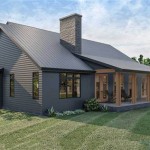House Plans With 2nd Floor Balcony: Enhancing Design and Functionality
House plans incorporating a second-floor balcony represent a desirable architectural feature that combines aesthetic appeal with functional outdoor living space. These balconies offer opportunities for relaxation, entertainment, and capitalizing on views, while simultaneously enhancing the overall curb appeal and perceived value of a property. Careful consideration of design, structural integrity, materials, and building codes is crucial to ensure a successful and satisfying outcome.
The inclusion of a second-floor balcony in house plans requires a comprehensive understanding of various factors, ranging from the intended use of the balcony to the prevailing climate conditions. This article will explore key aspects of designing and implementing house plans with a second-floor balcony, highlighting design considerations, structural requirements, and material choices.
Design Considerations for Second-Floor Balconies
The design phase is paramount in determining the success of a second-floor balcony. This process involves evaluating several crucial factors impacting the balcony's appearance, usability, and integration with the overall architectural aesthetic. The primary objective is to create a space that complements the home's design while providing a comfortable and functional outdoor area.
One of the first design considerations is the intended use of the balcony. Will it primarily be a private retreat for relaxation, or will it serve as an entertainment area for guests? The intended use will dictate the size and layout of the balcony. A small balcony may suffice for solitary relaxation, while a larger balcony is necessary for accommodating furniture and multiple people.
The location of the balcony is another critical design element. Typically, balconies are situated off master bedrooms, living rooms, or dining areas to provide easy access. The orientation of the balcony should be considered to maximize sunlight exposure during desirable times of the day and minimize exposure during harsh weather conditions. For example, a south-facing balcony in a northern climate will receive more sunlight during the winter months. Conversely, in warmer climates, shade structures may be needed to mitigate excessive heat gain.
The style of the balcony should be consistent with the overall architectural style of the house. A modern home may benefit from a sleek, minimalist balcony with glass railings and clean lines. A traditional home, conversely, may be better suited for a balcony with ornate railings and decorative trim. The architectural style and proportions must be carefully considered to ensure the balcony seamlessly integrates with the existing structure.
Privacy is another essential design consideration. The balcony should offer a degree of privacy from neighbors and passersby. This can be achieved through the use of privacy screens, landscaping, or strategically placed walls. The height and positioning of the balcony itself can also contribute to privacy.
Accessibility is especially important. The balcony should be easily accessible from the interior of the house. Consider the placement of doors and windows leading to the balcony to ensure smooth traffic flow. If the balcony is intended for use by individuals with mobility limitations, appropriate accessibility features, such as ramps or wider doorways, should be incorporated into the design.
Structural Requirements for Second-Floor Balconies
The structural integrity of a second-floor balcony is of utmost importance. A balcony must be designed and constructed to withstand the weight of occupants, furniture, and environmental loads, such as wind and snow. A qualified structural engineer should be consulted to ensure the balcony meets all relevant building codes and safety standards.
The load-bearing capacity of the balcony is a primary structural consideration. The balcony must be able to support the anticipated live loads (people and furniture) and dead loads (the weight of the balcony structure itself). Local building codes specify minimum load requirements for balconies, and these codes must be strictly adhered to. The structural engineer will calculate the required size and spacing of beams, joists, and other structural members to ensure adequate load-bearing capacity.
The attachment of the balcony to the house is another critical structural aspect. The balcony must be securely attached to the main structure of the house to prevent movement or collapse. This is typically achieved through the use of structural connectors, such as bolts, screws, and lag bolts, which are designed to withstand shear and tension forces. The type and size of the connectors will depend on the size and weight of the balcony, as well as the materials used in its construction.
Waterproofing is essential to prevent water damage to the balcony structure and the interior of the house. Proper flashing and drainage systems must be installed to direct water away from the building envelope. The balcony surface should be sloped slightly to allow water to drain freely. Waterproof membranes can be applied to the balcony surface to further protect against water infiltration.
Railing height and construction are crucial for safety. Building codes specify minimum railing heights for balconies to prevent falls. The railing must be strong enough to withstand lateral loads, such as someone leaning against it. The spacing between railing components must also be limited to prevent children from climbing through or becoming trapped.
Consideration of seismic activity is necessary in earthquake-prone areas. The balcony must be designed to withstand seismic forces and prevent collapse during an earthquake. This may involve the use of specialized structural connectors and reinforcing techniques.
Material Choices for Second-Floor Balconies
The materials used in the construction of a second-floor balcony play a significant role in its appearance, durability, and maintenance requirements. The selection of appropriate materials requires careful consideration of factors such as climate, budget, and desired aesthetic.
Wood is a popular choice for balcony construction due to its natural beauty and warmth. However, wood is susceptible to moisture damage, rot, and insect infestation. Pressure-treated lumber is often used to improve the durability of wood balconies. Regular maintenance, such as staining or painting, is required to protect wood from the elements.
Composite decking is a low-maintenance alternative to wood. Composite decking is made from a combination of wood fibers and plastic, making it resistant to moisture, rot, and insects. It is also available in a wide range of colors and styles to complement the home's architecture. While more expensive than wood, composite decking requires less maintenance and has a longer lifespan.
Metal is another durable option for balcony construction. Aluminum and steel are commonly used for balcony railings and structural components. Metal balconies are resistant to rust and corrosion, and they require minimal maintenance. Metal can be powder-coated in a variety of colors to match the home's exterior.
Concrete is a strong and durable material that is often used for balcony decks. Concrete balconies are resistant to fire and weather damage. However, concrete can be expensive and require specialized construction techniques. A waterproof coating is necessary to protect concrete from water damage.
Railing materials can significantly impact the appearance of the balcony. Wood, metal, glass, and composite materials are all commonly used for railings. The choice of railing material should complement the overall design of the balcony and the home.
The selection of appropriate fastening hardware is critical for the longevity of the balcony. Stainless steel or galvanized fasteners should be used to prevent rust and corrosion. The size and type of fasteners should be appropriate for the materials being joined and the loads they will be subjected to.
In summary, incorporating a second-floor balcony into house plans demands a thorough and integrated approach. Design considerations should address the intended use, location, style, privacy, and accessibility of the space. Structural requirements necessitate calculations for load-bearing capacity, secure attachment to the house, waterproofing, railing height and construction, and seismic activity. Material choices should balance aesthetic appeal with durability, maintenance needs, and cost-effectiveness. By carefully considering these factors and consulting with qualified professionals, homeowners can create a beautiful and functional second-floor balcony that enhances their living space and adds value to their property.

Modern House Design 2024005 Pinoy Eplans Two Y Plans Construction Plan

Small Two Y House Design With Wraparound Balcony Pinoy Designs

Havana Two Y House With Spacious Terrace Pinoy Eplans

Charming 2 Story Floor Plan With Balcony

Php 2024021 Two Y House Plan With Balcony Pinoy Plans

N House Plans Free 90 2 Y Designs With Balcony Design

Double Y House Plan With Balcony Pinoy Designs

Carlo 4 Bedroom 2 Story House Floor Plan Pinoy Eplans

Affordable Modern Two Story House Plan With Large Deck On Second Floor 9690

Two Story House Plans Series Php 2024012 Design

